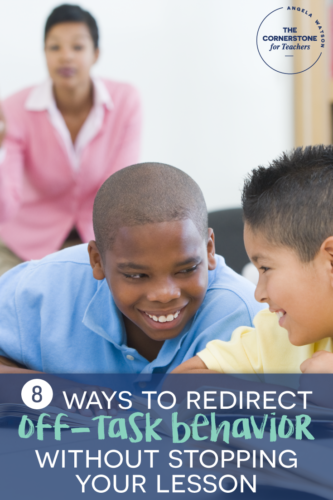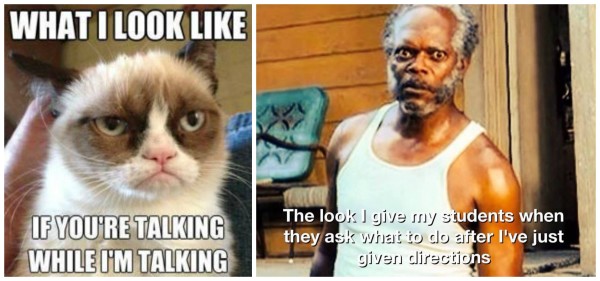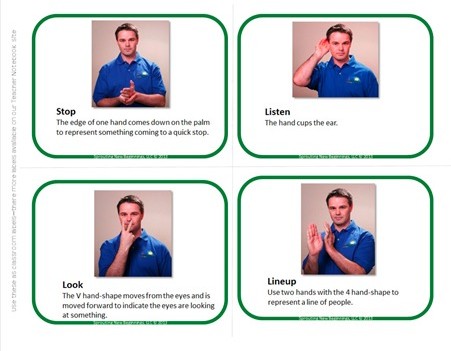Do you continually have to stop your lessons due to a group of off-task students?
Are you frustrated because you’re losing too much class time to addressing disruptions?
Here are 8 ways to redirect off-task behavior without interrupting your lesson or allowing your entire lesson to be derailed.

1. Use fewer words and less emotion.
It’s easy to drift into lengthy lecturing, nagging, and yelling questions we don’t want to hear the answers to. So, train yourself to start using a handful of phrases that are short and to the point. I like:
- I need you to __.
- Please ___.
- Let’s stay focused.
- I don’t like that.
- Not appropriate.
- Stay with us.
For the first redirection to the class or an individual student, I usually keep it light. I’ll say, “Stay with us” with an encouraging smile that communicates: This is going to be good–don’t miss out!
For the second redirection, I’ll say, “I need you to follow along” with wide eyes, raised eyebrows, and nodding to communicate: You’re going to work with me here, people, right? Come on, you can do this!
For the third redirection, I’ll give a cold stare and a blank, expressionless face, and say in a monotone voice, “Not appropriate. We’re reading the text right now” to communicate: This behavior is not okay, and you know it.
It’s important not to show anger, as that often escalates or feeds disruptive behavior and will immediately get the attention of students who were engaged but now want to watch the drama unfold. Don’t match the intensity of students’ behavior: tone yourself down, which encourages them to tone down. Showing quiet disappointment or disapproval in your facial expression and tone is enough to communicate a strong message without distracting the students who are on-task.
2. Teach kids specific non-verbal directives, like hand signals or sign language.
Show your students the signs for please, thank you, sit down, quiet, stand up, line up, yes, no, etc. This way, you can give reminders and directives without having to stop your lesson, repeat yourself, or nag.
You can also work with specific students to create individual hand signals. For example, a student might want to have a hand signal she or he can give you to indicate, “I’m getting really frustrated and need a break” and you might want a signal that says, “You’re doing __ again and you’re supposed to ___, remember?” These hand signals are generally meaningless to the rest of the class–if anyone asks, just say, “That’s a special sign between me and her. She knows what it means.”
3. Stand near the off-task kids but keep eye contact with the on-task kids.
As you’re teaching, walk over to where the off-task behavior is occurring. Don’t look at the kids who are being disruptive or acknowledge them, as that will shift the gaze of the rest of the class, too. Continue looking at and talking to the kids who are on-task; just stand closer to the students who are off-task.
If a kid doesn’t get the hint, rest your hand on the edge of his or her desk while you continue to teach. When the student gets quiet again, walk away without ever making eye contact or acknowledging the misbehavior. This works very well with about 90% of students, in my experience. If needed, lean down and whisper a short instruction ( “I need you to ___”) and then walk away. Don’t wait for the child to stop acting out, because that can turn into a power struggle. Say it with confidence, and then walk away so the child has a few moments to self-correct.
4. Pair up a 3 second freeze with The Teacher Look.
Once you’ve established a strong rapport with kids, you can be confident the ice cold stare (aka the “Are you kidding me?” look) will stop most misbehavior immediately. Generally, kids who truly like and respect their teachers don’t want to be on the receiving end of the teacher’s disapproval.

My teacher look is a cross between these two, depending on how obnoxious the off-task behavior is.
I’ve heard many teachers say that The Teacher Look doesn’t work for them, because the kids who need to see it aren’t looking at the teacher. Here’s what you do: during your lesson, stop yourself dramatically mid-sentence and freeze/glare, like this:
[Talk to the class in a normal voice and look at the students who are on-task] “So, I want to hear your thoughts on…[quickly cut your eyes over to the kids having side conversations; freeze and glare at them for 3 seconds in dead silence, then look back at the on-task students]…the different strategies your group shared just now. Raise your hand if…”
Then continue on with the lesson as normal. The off-task students will usually notice that the room suddenly fell silent, and you don’t have to interrupt the rest of the class’ train of thought by saying a word. If the engaged students are furiously taking notes or otherwise involved in the activity, they often won’t even notice the freeze/look.
When the off-task behavior is really disruptive and distracting the whole class, the freeze/look is very effective at not only letting the kids who are off-task know that you notice what they’re doing, but also letting rest of the class know you’re aware of the misbehavior and you’re not going to tolerate it. If the kids don’t get back on-task, you don’t have to stop your whole lesson. You can keep right on teaching without fear of losing respect of the rest of the class, because you have acknowledged the problem. Then you can…
5. Create a natural break in the lesson to talk privately with students who are being disruptive.
Ask the class to do a quick pair/share, turn-and-talk, quick guided practice activity, or solve a sample problem independently. Then use that moment to quietly walk over to the kids who are misbehaving. You can give a quick correction (one of your go-to phrases from strategy #1, perhaps) or talk with them about their choices.
6. Ask simple questions that prompt students to self-correct.
Try asking questions that require the child to think about what she or he is doing and help the child determine a more appropriate behavior. This strategy works well because you don’t have to give command to kids which they might then rebel against, and you don’t force them into a position where they have to give in because they were never told what to do.
What should you be doing right now? is my absolute favorite question for promoting self-correction, and it works in just about any situation. You can also try replacing your teacher-direct commands with problem-solving prompts, like this:

Usually when I ask these types of questions, students will pause, think, and then self-correct without any problems. They’re effective because students determine the solution and choose a different behavior, and instead of wearing us both down with more nagging, I get to say something positive and encouraging afterward (“Thank you” or “That’s exactly right.”)
7. Involve students in the lesson to engage, not embarrass.
It’s great to call on off-task students during a lesson, but only for the purpose of drawing them back into the lesson, not for shaming them for not following along. If you ask a question you know the student won’t be able to answer, that does nothing to keep up the lesson momentum or help the child successfully participate. It creates frustration for everyone involved when the entire class is staring impatiently at someone who has no idea what’s going on.

Instead, say, “[Off-task student], I’m going to call on you in one minute to demonstrate how to solve #4. [On-task student], would you solve #3 for us right now?” That gives the student a chance to prepare and also figure out what’s going on before being put on the spot.
You can also draw the off-task student into the activity through a task that doesn’t require him or her to have been paying attention. It could be as simple as: “___, what color highlighter should I use to mark our sight words here?” That gives the child some ownership over what’s happening in the lesson and allows him or her to begin participating again. You can also ask the off-task student to hold the book up as you read, pass out materials, come up to the board and take notes for the class as you explain something, and so on.
8. Provide support until the students experience success.
Sometimes your attempts to engage kids in the lesson work only for minute or two. If you see that a student is getting off-task again right after a subtle redirection or attempt to engage, you may need to be more persistent.
Don’t lecture or nag, just walk over to the off-task students and say, “So we’re discussing #8 right now with partners. Can you two share how you got your answers?” Stay there for a few moments to make sure the students understand what they need to be doing and are experiencing success. Give a compliment before you walk away to end the exchange on a positive note: “I knew you could do it!” “That’s exactly right, thanks” or “That’s it–keep it up.”
Those are some strategies that have worked for me. How do you redirect students who are off-task without interrupting your lesson?

Angela Watson
Founder and Writer
Sign up to get new Truth for Teachers articles in your inbox
Discussion
Leave a Reply
OR

Join our
community
of educators
If you are a teacher who is interested in contributing to the Truth for Teachers website, please click here for more information.

















Hi Angela,
Thank you for the tips.. 🙂
How about if I ask them to separate them from the group? Is it allowed? Is it appropriate?
I teach 5th grade in one of Indonesia’s school..
Waiting for your reply.. 🙂
Hi there, yes, I do think it’s appropriate to separate disruptive students from the group sometimes. Set that up as part of your class rules, so students know if they are asked X amount of times to stop, they may need to separate themselves from the group to make sure they’re not preventing other kids from learning.
I don’t approach this as a punishment because that can turn into a power struggle: it’s just a quiet conversation I have with the individual (“Your friends can’t focus when you keep talking to them. We need you to push you desk back from the group and focus on your work for awhile. When you feel like you can be in control of your talking again, you are welcome to move your desk back. Thanks for cooperating.”)
For the kids who run into this problem a lot, you won’t need to have this conversation every time–you can give them a look or a certain hand signal that lets them know they have a warning, and if you have to give 3 warnings, then they need to move away from the group.
You may find that these kids volunteer to move away from the group sometimes: they find it empowering to be able to create their own space and regulate their own needs. Often I’ve seen disruptive students recognize that a conflict with a peer is going to escalate and they move their own desks away, and then move back when they feel like it.
Good afternoon. I usually ask the child that is disrupting his/her group to help me move their desk away for a few minutes to help he/she think of their own idea/answer related to the topic they are learning. I remain around the area. Then I ask the child, quietly, if they thought of their idea/answer to share with group. Usually the child answers, yes, then I invite the child to help me move desk back to group and share his/her idea/answer to topic learned.
Already doing some of these solutions. So glad our solutions are right on point together!
It always good when someone reaffirms what you’re already doing, isn’t it? I’m glad these ideas are effective in your classroom.
Hello! First, I am a big fan and have been using your management tips and other ideas since I found Mspowellsmanagent(something.com) …over 6 years ago:) I too use many of these techniques with students, and how found them effective, however, in recent years, I seem to always have one or two students who seem to interrupt my lesson often (they just have to make a comment, make a noise, etc) I always wonder if I haven’t earned their respect enough or if they are still (after months!) Pushing their limits. I have used a strategy for these “repeat offenders” where they have a post it “fringed” into strips, and they lose a strip every time they call out. If they keep their strips for a pre-determined amount of time, they earn something. It has worked, but is difficult to do for multiple students. Any suggestions? Does that sound like a good strategy? Thank you for your help!
Yes, I’ve done something similar with counters, though not for more than 2 kids at at time. I haven’t found it particularly hard to manage because I just kept the counters on their desks and silently took one away when they interrupted. I didn’t stop the lesson or say anything to the student at all, just kept walking past and took one and put it in my pocket. The kids were responsible for bringing me their counters at recess time so we could talk about their choices. Maybe the location of the fringed strips is what’s making it trickier for you to keep up with?
Also, my goal was always to wean the kids off this need for such a concrete reminder. It usually took only a few weeks for the kids to realize how much they were interrupting and re-train themselves to exhibit more self-control. The daily conversations about their choices and the positive affirmations were what made the real difference, I think: the counters just made the intangible concept of “being on task” more tangible.
How many counters or fringes did you begin with? I have a couple of 5th grade students who I would like to try this with, but I’m not sure how many to start with?
Hi Angela,
Can you give an example of what you use for a counter and do they sit on the student’s desk? Thanks!
Hi Angela! Thank you very much for your tips. Let’s put them in action! We really need new ideas with this “new” generation oc children. Best regards from portugal.
Great! I do some these already. But kids usually get it, if it is consistent.